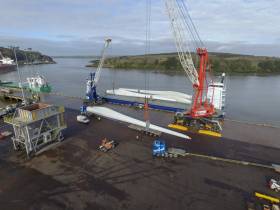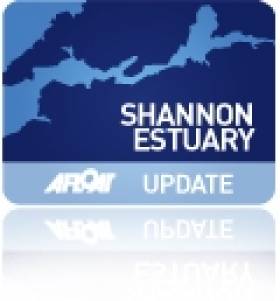Displaying items by tag: Foynes Port
New railway tracks have been laid for the reopening of the Foynes Port-Limerick City freight line, marking a major milestone of the project, with phase one progressing well, reports the Limerick Leader.
Works begin in November, 2022, as Afloat previously reported, to reopen the rail-line connecting the Shannon Estuary port, and the city. Originally, the line opened in 1858 and continued in use for more than a century until it closed to passenger traffic in 1963.
Freight services, however, continued until 2001, when such services stopped with the rail-line declared inactive, though since then the line has remained under the stewardship of Irish Rail /Iarnród Éireann.
The infrastructure project on the 42 kms line, funded by the Department of Transport and the National Transport Authority, is expected to be ready for operations in December 2025, with freight services scheduled to start in early 2026.
Among the works of phase one, has been the removal of existing old track rails, sleepers, and fixings, which are made up of jointed track placed on wooden sleepers, as they could no longer be used.
Sisk is the main contractor for the project, along with subcontractor Steconefer, which has started to replace the existing track with the replacement and installation of new materials.
Afloat also adds that this will involve laying new concrete sleepers and rails to match the existing track alignment, which will be welded to form continuous welded rail.
The track-laying stage has begun near Askeaton, and according to Sisk, it is expected that all tracks will be laid with completion by the end of 2024.
Russian Cargo Ship Arrives in Foynes on the Shannon Estuary
The Russian-flagged general cargo vessel, Pola Anatolia, has arrived at Foynes Port in County Limerick after a seven-day voyage from Kaliningrad.
The Baltic port of Kaliningrad is the only ice-free port of Russia. It is home to the headquarters of the Baltic Fleet of the Russian Navy.
Pola Anatolia was built in 2018 and sails under the flag of Russia.
Its carrying capacity is 7678 tonnes DWT.
Growth Surges As Shannon Foynes Port Company Continues Record Operating 2017 Profit
#ShannonEstuary - Maintaining a strong growth pattern last year, Shannon Foynes Port Company (SFPC), delivering a record EBITDA (earnings before interest, tax, depreciation and amortisation) of €6.6million, its annual report reveals.
In what was the third consecutive year of record profits for the company, 2017’s return was up 2.8% on 2016, with turnover up by 5.7% to 13,980,326. Last year also saw cargo volumes (11.3m tonnes) surpass peak levels of the boom of the last decade and have now grown by 18% in the three years since 2014.
Profit before tax increased to €4.3m (2016: €4.1m), also the highest level in the Company’s history.
The profits were achieved in a year in which the company – the largest bulk port company in Ireland - also invested over €6.5m in enhancing its asset base, including through acquiring a high capacity Liebherr LHM 420 mobile crane and other port infrastructure upgrades.
Significantly also, an operating margin of 34.3% was delivered – six times what it was at the height of the Celtic Tiger boom when a 5.5% margin was delivered. This, SFPC CEO Pat Keating said, is confirmation that the company is delivering on its objectives of transitioning the business into Ireland’s premier deep-water port.
Said Mr Keating: “We are very pleased with our performance in 2017, which was positive across all metrics. Cargo volumes are a key barometer for port companies and last year we were up by 4% at our general cargo terminals of Limerick and Foynes. This growth reflects the resurgence in the domestic and export economy where, for example, agricultural, petroleum and construction products were particularlystrong. In addition, renewable and recyclable related cargoes also performed strongly.”
While the business is now consistently generating healthy profits, substantial demands on cash flow exist, he continued. “These include the extensive investment programme underpinning the company’s long-term masterplan, Vision 2041. These investments are vital in order to significantly expand our infrastructure in order to keep pace with customer demand.
“Accordingly, it is vital that we continue to grow the business efficiently so that we can build on recent success. Since 2011, the base year of Vision 2041, tonnage at our general cargo terminals has increased by just over 53% and we expect that tonnage throughput will continue to trend upward in the coming years, in line with the mid to high scenario projected in Vision 2041," the CEO said.
The performance enabled the company to continue its record investment programme, as outlined in Vision 2041. With the €12m Phase 1 completed over the two-year period ending 2016, a planning application is in progress for a further €22m investment covering Phases II to IV. These phases will comprise a significant extension to berthing facilities at Foynes, including the development of the recently acquired 38 hectares of land for port activity. Funding for this record expansion is in place and has been co-funded by the EU Ten-t program.
Said SFPC Chairman David McGarry: “The Board is fully committed to delivering on the strategic vision as outlined in the Shannon Foynes Master Plan Vision 2041 and to that end, will be actively pursuing the implementation of all key deliverables identified in the Plan. Whilst it is early days in the Vision 2041 plan period, we are very much on track to achieve its growth projections.” Mr McGarry said, that a number of key projects must be delivered for the port authority reach its potential, including the Limerick to Foynes Road Scheme but delivery of this, he said, is becoming more and more urgent. The reinstatement of the Limerick to Foynes rail line for freight use, likewise, is a key project. He also revealed that the performance over recent years ensures that SFPC continues to declare and pay dividends to the Exchequer. 2017 saw a payment of €250,000, over two and a half times the company’s first dividend payment two years ago.
With regard to Brexit implications, he said: “While there are obvious economic threats arising from Brexit, we believe it also presents opportunity. Brexit is a disruptor and has forced the freight sector, including its policy makers, to review current systems and traffic paths. To this end, we have been very active during 2017 and note that the European Commission, in its CEF mid-term review intend to extend the North Sea Mediterranean Corridor to include SFPC. This is a major change and one which should enhance our ability to access future European Funding under the CEF (Connecting Europe Facility) budget.”
Investment of €50m in Foynes Port
#ShannonEstuary - This month work will begin on the first element of a major restructuring of the port of Foynes in Co Limerick.
According to RTE News, it is part of a €50m investment in transforming the port into one of the biggest bulk harbours in Europe.
Shannon Foynes Port Company will spend €12m on transforming the existing East Jetty area, and reclaiming a 3.45 acre section of the port to create a bigger foreshore area of activity and enable improved bulk discharge times.
The expansion of the port will add an additional 35,000 square metres of additional berthage and create more open quay storage at the port.
It will enable the company to accommodate larger container cargo ships, enabling ships of 40,000 tonne capacity to berth at the new port.
For more on the development of the mid-west port, click here.
Foynes Port Company to Get Grant of €4m from EU for Development Works
#ShannonEstuary - Another boost this week for Shannon Foynes Port Company, is the news that funding worth more than €4m is on the way from the European Union.
As the Limerick Leader writes the company has been cleared for almost €4.5m in EU transport funds, which will be used for further development work at the Foynes facility.
Two years ago, SFPC received over €3m from the same fund. This time, the grant has been allocated to join existing jetties at Foynes, infill an area behind these jetties, and develop 90 acres of land for ancillary port storage and port-related activities.
MEP Deirdre Clune, a member of the EU transport committee, said it was a vote of confidence in Limerick.
For more on the story click the link here.
Foynes Port Rejects Warnings About Shannon Water Extraction
#ShannonWater - Plans for a pipeline by Irish Water to Dublin are no threat to activities says Shannon Foynes Port Company.
The mid-west port writes The Irish Times, has rejected warnings that Irish Water’s planned extraction of water from the river Shannon for Dublin homes and business could hit operations at Limerick port.
Campaigners against the proposed pipeline said it believed Irish Water’s plan to take out 330 million litres a day from the Shannon could lower water levels at the mouth of the river.
“If there isn’t sufficient strength of speed and flow – that is, if there is less water – the shipping channels will silt up and ships will not reach Limerick port. That would be a massive economic blow,” said Gerry Siney of the River Shannon Protection Alliance.
Port authorities said they were satisfied the pipeline would not “materially impact” dock operations at the facility, which relies on deep-water channels for much of its traffic.
Mr Siney described the plan as “ludicrous”, adding: “This really doesn’t stand up environmentally, economically and socially.”
For more the newspaper has a report here.
EU Funding of €3m to Drive Shannon Foynes Masterplan
#EUPortFund - Funding of €3m from the EU has been secured for Shannon Foynes Port Company, the bulk of which will be spent on building a new East Jetty at the Limerick port, writes The Limerick Leader.
But some €800,000 has also been assigned to examine the feasibility of restoring the rail link to the facility. The East Jetty and the restoration of the rail link are part of the port company's 30-year master plan, Vision 2041. Earlier this year, a seven-year investment plan of €50m got underway and work began on developing the East Jetty which is expected to cost €12.5m.
The €3m funding has come under the Connecting Europe Facility, which has rolled out a record €13.1 billion investment plan for 276 transport projects across Europe. The port company was one of some 700 applicants for the fund and invested considerable time and effort in making the application.
The work on the East Jetty will completed in two phases. The first phase, which has begun, will involve the construction of a retaining wall along berth six, the removal of the existing viaduct and the infilling of 14,500 square metres behind berth six to create substantial new open quay storage.
Preliminary work will also take place on phase two, which involves linking the East and West jetties but construction of phase two is not expected to begin until 2019. The company has repeatedly made clear that it sees the restoration of the rail link as important for the continuing and future development of Foynes and of the estuary generally.
For more on the story click here
Foynes Port Redevelopment Continues With Dredging Operations
#EastJettyInfill – Work on a major €50 million investment of Foynes Port that began in February to transform the Shannon Estuary port into one of the biggest bulk harbours in Europe continues with dredging operations, writes Jehan Ashmore.
The restructuring work of Foynes Port sees the redevelopment of the East Jetty which forms phase one of the work costing €12.5m towards the in-filling of 3.45 acres.
When completed this new open quay storage area will cater for 40,000dwt vessels to berth alongside to load and will enable improved bulk cargo discharge times.
According to Shannon Foynes Port Company, the Notice to Mariners No. 2 of 2015 states that the Jenny T, a suction dredger/dump barge is anticipated to carry out dredging and associated dumping works for approximately two weeks, dependent on weather conditions.Operations will be restricted to daylight hours only.
At the neighbouring West Jetty, this forms phase two of the project as this stretch of the Co. Limerick Port will be connected with the East Jetty.
The expansion of the port will add an additional 35,000 square metres of additional bertage and create more open quay storage at the port.
SFPC also plan over time to be able to accommodate 80,000 tonnes capacity vessels, the world's largest cargo vessels to unload at Foynes, making it one of the few ports in Europe capable of handling these massive ships. Currently these vessels transit the Panama Canal.
German Cruise-Goers Visit Munster Ports
#MunsterCruise – German tourists are on a cruise around Ireland which included a visit to Foynes yesterday followed by a short overnight passage to Cobh today, writes Jehan Ashmore.
The cruise on board Phoenix Reisen's Amadea 29,008 tonnes vessel marked the final caller to Foynes this season, which was opened by Holland America Line's 37,845 tonnes Prinsendam a month ago.
Amadea, formerly the Japanese cruiseship Asuka, is the 'flagship' of the German cruise operator which runs the 1984 built Artania, well known to cruise buffs as the former Royal Princess. In addition the small fleet includes Albatros, originally Royal Vikling Sea, one of a trio of Finish built sisters commissioned for Royal Viking Line.
A third caller was due to start the season at the Shannon port, Voyages of Discovery's 15,396 tonnes Voyager, however the vessel had technical problems forcing the cruise to be curtailed in Killybegs.
Large-Sized Energy Project Vessels Dock in Foynes Port
#FoynesPort - Shannon Estuary with its enormous investment potential and capability in handling large vessels due to deep-water channels, was clearly evident with the call last month to Foynes Port of the giant 55,000 tonne Santa Fe.
The 200m long ship was carrying one of the largest ever cargo of wind turbines to come into Ireland and had arrived in Foynes from China. On completion of unloading the wind turbine installations for onward road transportation along the western seaboard, Santa Fee departed for Rotterdam.
As previously reported on Afloat.ie, Shannon Foynes Port Company (SPFC) also handled the 82,000dwt London 2012 earlier this year.
The dry-bulk-carrier discharged cargo at the Aughinish Alumina jetty which is one of six terminals of the SFPC that published its Vision 2041 Masterplan to attract international investors to establish manufacturing and potentially transshipment operations on the estuary.
SFPC is the only Irish port authority with sufficient natural water depths to accommodate the global trend for a doubling and more of in the size of vessels (up to 80,000 tonnes) over the coming decade or more.
This is due to the enlargement of the Panama Canal - the world's most important shipping route, which influences vessel sizes globally.
As well as handling the Santa Fe, the SFPC hosted the first visit of the Polarcus Amani on the last day of July. The ultra-modern, super high ice class, 12-14 streamer 3D/4D seismic research vessel involved in operations off the west coast of Ireland.
Polarcus Amani berthed to change crew and receive gas oil bunkers. Inver Energy Ltd supplied the 600 tonnes of fuel directly by pipeline from the new Atlantic Fuel Supply Company terminal located in Foynes.
SFPC expects to host considerably more activity in the coming years to service the planned exploration of potential gas and oil fields located off the western seaboard. Offshore supply bases have previously operated out of Foynes.

































































